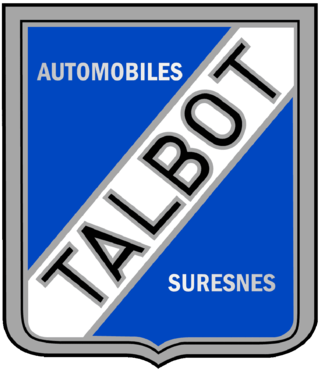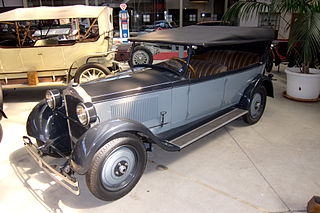
The Ford GT40 is a high-performance endurance racing car designed and built by the Ford Motor Company. It grew out of the "Ford GT" project, an effort to compete in European long-distance sports car races, against Ferrari, who had won the prestigious 24 Hours of Le Mans race from 1960 to 1965. Ford succeeded with the GT40, winning the 1966 through 1969 races.

Pontiac, or formally the Pontiac Motor Division of General Motors, was an American automobile brand owned, manufactured, and commercialized by General Motors. It was originally introduced as a companion make for GM's more expensive line of Oakland automobiles. Pontiac quickly overtook Oakland in popularity and supplanted its parent entirely by 1933, in turn establishing its position as one of GM's dominant divisions.

The AC Cobra, sold in the United States as the Shelby Cobra and AC Shelby Cobra, is a sports car manufactured by British company AC Cars, with a Ford V8 engine. It was produced intermittently in both the United Kingdom and later the United States since 1962.

The Chevrolet Impala is a full-size car that was built by Chevrolet for model years 1958 to 1985, 1994 to 1996, and 2000 to 2020. The Impala was Chevrolet's popular flagship passenger car and was among the better-selling American-made automobiles in the United States.

Allard Motor Company Limited was a London-based low-volume car manufacturer founded in 1945 by Sydney Allard in small premises in Clapham, south-west London. Car manufacture almost ceased within a decade. It produced approximately 1900 cars before it became insolvent and ceased trading in 1958. Before the war, Allard supplied some replicas of a Bugatti-tailed special of his own design from Adlards Motors in Putney.

Talbot-Lago was a French automobile manufacturer based in Suresnes, Hauts de Seine, outside Paris. The company was owned and managed by Antonio Lago, an Italian engineer that acquired rights to the Talbot brand name after the demise of Darracq London's subsidiary Automobiles Talbot France in 1936.

Delage is a French luxury automobile and racecar company founded in 1905 by Louis Delâge in Levallois-Perret near Paris; it was acquired by Delahaye in 1935 and ceased operation in 1953.

The Ferrari 250 is a series of sports cars and grand tourers built by Ferrari from 1952 to 1964. The company's most successful early line, the 250 series includes many variants designed for road use or sports car racing. 250 series cars are characterized by their use of a 3.0 L (2,953 cc) Colombo V12 engine designed by Gioacchino Colombo. They were replaced by the 275 and 330 series cars.

The Aston Martin Virage is an automobile produced by British luxury automobile manufacturer Aston Martin as a replacement for its V8 models. Introduced at the Birmingham Motor Show in 1988, it was joined by the high-performance Vantage in 1993, after which the name of the base model was changed to V8 Coupe in 1996.

Gillet is a Belgian automobile manufacturer, started in 1992 by former racing driver Tony Gillet. The company produces the Vertigo sports coupé, an ultra-lightweight (990 kg) 'bespoke' and hand-built sportscar. The slogan of the company is "Supercar and work of art Pure Pleasure!". The first Vertigo was powered by a Ford Cosworth 2.0-litre 4-in-line, later evolutions are powered by more powerful engines: the 3.0-litre Alfa Romeo V6 engine and the 4.2-litre Ferrari/Maserati V8 in the Vertigo .5.

The Lola A1GP was a vehicle designed to compete in the A1 Grand Prix. The car was standardised for every team to provide a level playing field for competing nations. It was designed to reduce the volume of "dirty air", allowing drivers to close in on the car in front, encouraging overtaking. The bodywork was mainly pre-impregnated carbon fibre composites. From 2008–09 Ferrari was consulted on the design and manufacture for all A1 Grand Prix cars. From the 2008-2009 season the Lola A1GP car was replaced by the A1GP Powered by Ferrari car.

The Isuzu Faster is a pickup truck that was manufactured and marketed by Isuzu between 1972 and 2002 over three generations. The Faster was succeeded worldwide by Isuzu D-Max, except in Japan and North America.

Statesman is an automotive marque created in 1971 by the Australian General Motors subsidiary, Holden. Statesman vehicles were sold through Holden dealerships, and were initially based on the mainstream Holden HQ station wagon platform, thereby providing more interior room and generally more luxurious features than their Holden-branded sedan siblings. Production ceased with the last of the WB series cars in January 1985.
Sipani Automobiles Ltd. was an Indian car manufacturer established in 1973, located in Bangalore. They mainly manufactured subcompact cars with fibreglass bodies. They also took over Auto Tractors Limited in 1991 and manufactured diesel engines and tractors in the old ATL factory in Pratapgarh, Uttar Pradesh.

The Phillips Berlina is a neo-classic car built in Pompano Beach, Florida. Debuting in 1980, it was designed by Charles W. Phillips in the style of the 1936 Mercedes-Benz 540K Special Roadster. It used stretched C3 Chevrolet Corvette underpinnings, coupled to fibreglass bodywork. As for the Corvette, power steering and brakes, powered tinted windows, and tilt steering were fitted. The fuel injected 5.7 litre V8 engine in the 1982 Berlinas offers 200 hp (149 kW) at 4,200 rpm, for a top speed of around 180 km/h (110 mph). The earlier carburetted version (L81) had 190 hp on tap. By 1982, a special "Coupé SE" version was also available.

The Opel 7/34 PS is a large but relatively inexpensive six-cylinder-powered car manufactured by Opel, introduced in October 1927. It was replaced in 1928 by the Opel 8/40 PS which was virtually identical except that the cylinder capacity had been increased. Significant changes to the chassis took place in February 1929, after which production of the model continued till September 1930. The 8/40 PS was replaced by the Opel 1.8 Liter in 1931, also a compact six-cylinder car.
The Spada Codatronca is an Italian-built supercar introduced by Spada Vetture Sport in 2008. A convertible version, the Spada Codatronca Monza, was introduced in 2012. Both cars used a modified chassis and engine from the Chevrolet Corvette C6, but featured all-new bodywork.

The Renault Nervasport was a straight-eight engined sporting luxury automobile introduced by Renault in March 1932 and produced until 1935. It was based on the larger and heavier Nervastella. A more streamlined version called the Nerva Grand Sport appeared in 1935 and replaced the Nervasport, remaining in production until the summer of 1937. As with many Renaults during the 1930s, type changes as well as small often cosmetic facelifts and upgrades appeared frequently.

The Oldsmobile Light Eight was an automobile produced by the Oldsmobile Division of General Motors in roadster, two-door coupe, four-door sedan from between 1916 and 1923. It was powered by a sidevalve V8 engine, the maker's first, and shared with the 1916 Oakland Model 50.

The Oakland Six was the first six-cylinder engine offered by the Oakland Motor Company in 1913 which became a division of General Motors in 1909. The Oakland Six was offered in many different model names that changed every year, along with several body styles and engine displacements until 1929, when the V8 was reintroduced, then in 1931 Oakland was renamed Pontiac. When Oakland became a division of GM and introduced the Oakland Four, Oldsmobile and Buick shared bodywork and chassis of their six-cylinder models with Oakland. When Chevrolet became part of GM in 1917, Oakland chassis and bodywork were shared with Chevrolet. Manufacture of the Oakland was completed in Pontiac, Michigan.


















